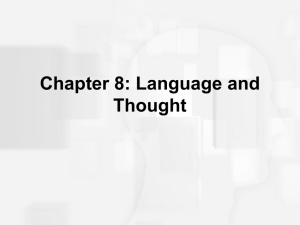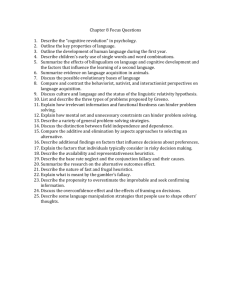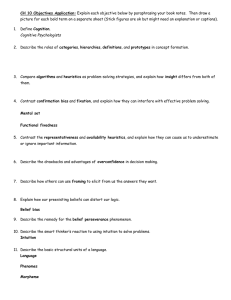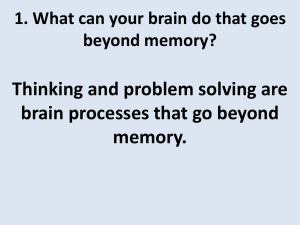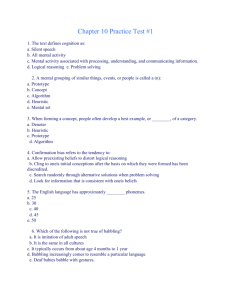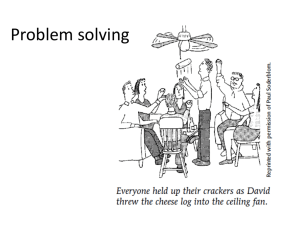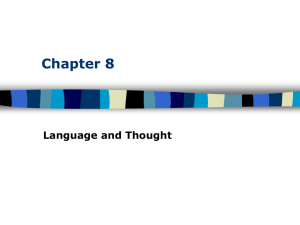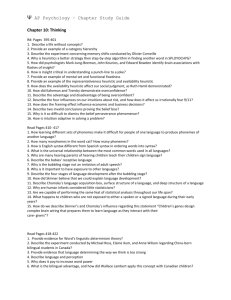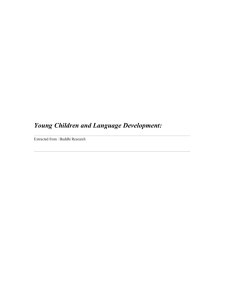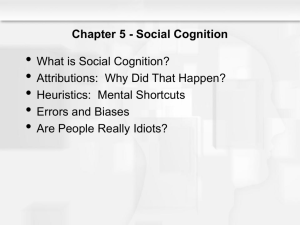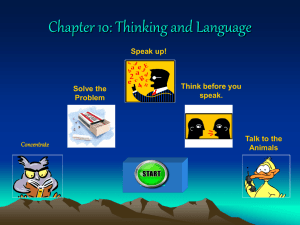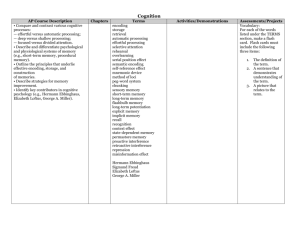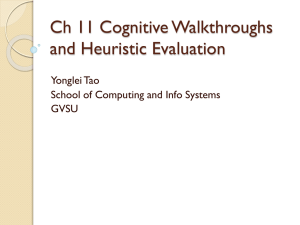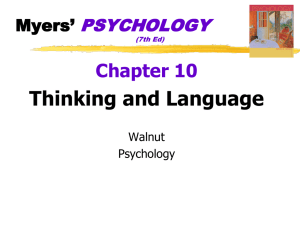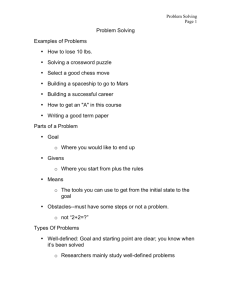Language and Thought The Late 19 th Century Theorists focused on
advertisement
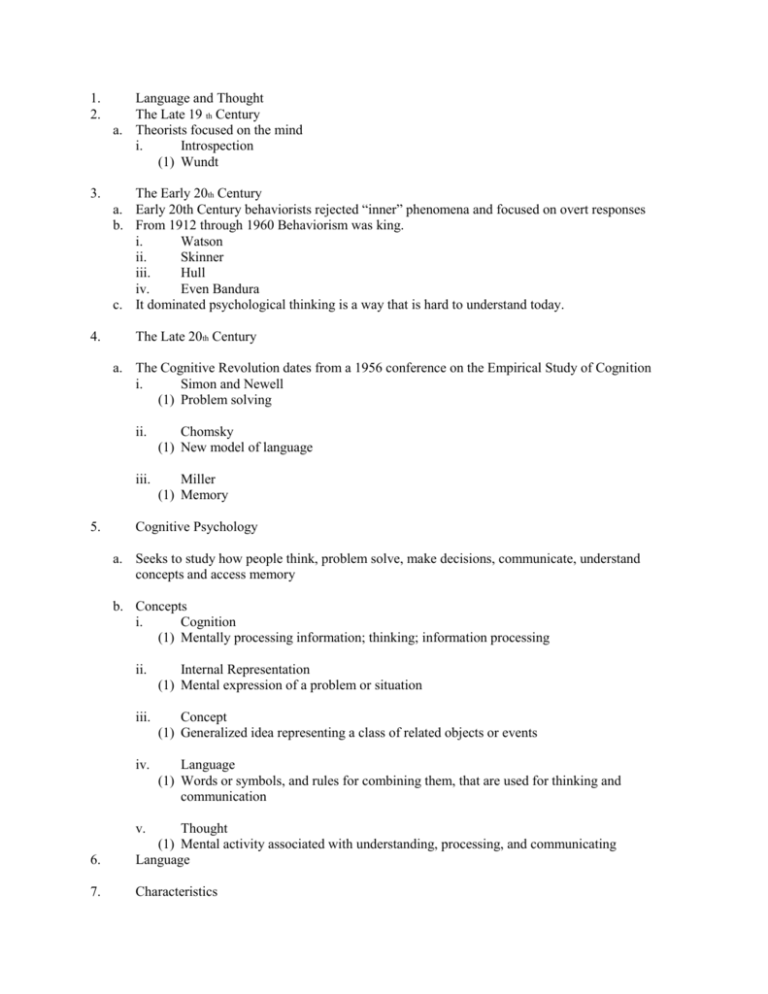
1. 2. Language and Thought The Late 19 th Century a. Theorists focused on the mind i. Introspection (1) Wundt 3. The Early 20th Century a. Early 20th Century behaviorists rejected “inner” phenomena and focused on overt responses b. From 1912 through 1960 Behaviorism was king. i. Watson ii. Skinner iii. Hull iv. Even Bandura c. It dominated psychological thinking is a way that is hard to understand today. 4. The Late 20th Century a. The Cognitive Revolution dates from a 1956 conference on the Empirical Study of Cognition i. Simon and Newell (1) Problem solving 5. ii. Chomsky (1) New model of language iii. Miller (1) Memory Cognitive Psychology a. Seeks to study how people think, problem solve, make decisions, communicate, understand concepts and access memory b. Concepts i. Cognition (1) Mentally processing information; thinking; information processing ii. Internal Representation (1) Mental expression of a problem or situation iii. Concept (1) Generalized idea representing a class of related objects or events iv. Language (1) Words or symbols, and rules for combining them, that are used for thinking and communication v. 6. Thought (1) Mental activity associated with understanding, processing, and communicating Language 7. Characteristics a. Defined i. Symbolism used to communicate ideas and concepts and problem solve b. All Language share three things in common i. Semanticity (1) True language conveys thoughts in a meaningful way with symbols ii. Generativity (1) The ability to combine words in new ways iii. Displacement (1) Ability to talk about objects that are not present 8. Linguistics a. Phonology i. Sound b. Morphology i. Meaningful unit c. Semantics i. Word d. Syntax i. Sentence e. Pragmatics i. Context and culture 9. Sound Meaning Words a. The phoneme is the smallest unit of sound. b. The morpheme is the smallest meaningful unit. i. Cat Undo (1) 1 2, Un do c. The first word is at about 1 year. (1) About 50 words in six months (2) Then 8,000-14,000 words by six years 10. Syntax a. The rules for making sentences out of words i. Noam Chomsky (1) Surface structure (2) Deep structure (3) Transformational grammar (4) http://www.hfac.uh.edu/COGSCI/lang/Entries/transformational_grammar.html 11. Pragmatics a. A Functionalist Approach i. Language use in context and as communication. b. Speech Acts i. A linguistic behavioral unit c. Discourse Cats 2, Cat s i. Conversation d. Social Referential Communication: Social conventions i. Learn specific forms that specify gender, age, or status. e. Indirect requests i. Egocentrism and Knowledge 12. a. b. c. d. e. f. Development Initial vocalizations Babbling The first word The vocabulary spurt The combination of words The expression of complex ideas, plural, & past tense. 13. Initial Vocalizations a. Similar across languages b. Crying, cooing 14. Babbling a. 4 Months i. Babbling always appears b. 6 Months i. Sounds begin to resemble surrounding language 15. First Word i. One year of age ii. Similar cross-culturally (1) Words for parents iii. Receptive language exceeds expressive language 16. The Vocabulary Spurt a. Begins at around 18–24 months with individual variation. i. Fast mapping ii. Over and underextensions 17. Combine Words i. End of second year ii. Telegraphic speech iii. Mean Length of Utterance (MLU) 18. Complex Ideas a. End of third year i. Plural, past tense ii. Overregularization 19. Bilingualism a. Research findings: i. Smaller vocabularies in one language, combined vocabularies average ii. Higher scores for middle-class bilingual subjects on cognitive flexibility, analytical iii. iv. v. 20. reasoning, selective attention, and metalinguistic awareness Slight disadvantage in terms of language processing speed Second languages more easily acquired early in life Greater acculturation facilitates acquisition Can Animals Develop Language? a. Dolphins, sea lions, parrots, chimpanzees i. Vocal apparatus issue (1) American Sign Language b. Allen and Beatrice Gardner (1969) i. Chimpanzee - Washoe (1) 160 word vocabulary c. Sue Savage-Rumbaugh i. Bonobo chimpanzee - Kanzi (1) Symbols (2) Receptive language – 72% of 660 requests 21. Theories of Language Acquisition a. Behaviorist i. Skinner (1) learning of specific verbal responses b. Nativist i. Chomsky (1) learning the rules of language (2) Language Acquisition Device (LAD) c. Interactionist i. Cognitive and Social communication theories 22. Brain and Language Disorders a. Broca's Area i. Aphasia b. Wernicke's Area i. Aphasia c. Dyslexia 23. Problem Solving 24. Mental Chronometry a. Reaction Time (1) Complexity (2) Stimulus-response compatibility (3) Expectancy (4) Speed-accuracy tradeoff b. Evoked Potentials 25. Concepts a. Defined i. Mental representation of a group of objects, people, events, etc. b. Function i. Help us to order our world into categories and to communicate with fewer words 26. Schemas and Event Scripts a. Types of concepts i. Artificial concepts (1) Clear (invented) definition ii. iii. Natural concepts (1) Share a set of characteristics Fuzzy concepts b. Prototypes i. Our best example of a concept ii. When you hear the word “dog” what dog comes to mind? c. Scripts i. Mental representation of an event 27. Types of Problems a. Problems of inducing structure i. Series completion and analogy problems b. Problems of arrangement i. String problem and Anagrams c. Problems of transformation i. Hobbits and orcs problem ii. Water jar problem 28. a. b. c. d. e. 29. Problem Solving Describe Elaborate Decision Plan Act Problem Solving Methods a. Trial and error i. Trying one solution after another in no particular order b. Algorithms i. A systematic procedure used to solve a problem c. Heuristics i. Using a rule of thumb strategy to problem solving that comes from our past experience in decision making and problem solving d. Hypotheses Testing i. 30. Using a control group and an experimental group to determine a working solution to a problem Algorithms & Heuristics a. Algorithms i. Systematic trial-and-error ii. Guaranteed solution b. Heuristics i. Shortcuts ii. No guaranteed solution (1) Forming subgoals (2) Working backward (3) Searching for analogies (4) Changing the representation of a problem 31. Barriers to Problem Solving Well defined versus ill defined problems Irrelevant information Functional fixedness Mental Set Unnecessary Constraints 32. Well-Defined versus Ill-Defined Problems a. Initial state, goal, and constraints are explicit b. One or more of the above is unclear a. b. c. d. e. 33. Irrelevant Information a. Fixating on information that does not aid the solution i. The Thompson family and the unlisted phone numbers 34. Functional Fixedness a. The inability to use familiar objects in new ways i. The string problem ii. (ex: A screwdriver can be used to pry open a can.) 35. Mental Set a. Continuing to use strategies that have worked in the past 36. Unnecessary Constraints a. The inability to solve a problem because we place limits on the solution that really do not exist. i. Assumptions (1) “The root of all evil.” ii. The dot problem 37. Culture, Cognitive Style, and Problem Solving a. Field dependence i. Relying on external frames of reference ii. Focus on the total context b. Field independence i. Relying on internal frames of reference ii. Focus on specific features c. Western cultures inspire field independence 38. Evaluating Alternatives and Making Choices a. Simon (1957) i. Theory of bounded rationality b. Making Choices i. Additive strategies (1) Compensatory decision models (a) Additive strategies (i) Box Score (2) Noncompensatory decision models (a) Elimination strategies (i) Must have, can’t have ii. Risky decision making (1) Expected value (2) Subjective utility (3) Subjective probability 39. a. b. c. d. e. Heuristics in Judging Probabilities The availability heuristic The representativeness heuristic The tendency to ignore base rates The conjunction fallacy The alternative outcomes effect 40. Representativeness a. Base a decision based on how much a new situation or object resembles our old prototypes 41. Availability a. Base a decision on what we have most available in our memory 42. Water Lilies 43. $20 44. How many pets? 45. Numbers 46. Anagram 47. Solutions to Insight Problems 48. Pitfalls in Decision Making a. The gambler's fallacy b. Overestimating the improbable c. Confirmation bias and belief perseverance d. The overconfidence effect e. Framing 49. The Gambler's Fallacy a. The belief that the odds of a change event increase if the event has not occurred recently 50. Overestimating the Improbable a. This represents the operation of the availability heuristic 51. Confirmation Bias and Belief Perseverance a. The tendency to seek confirmation rather than discomfirmation. b. The tendency to maintain beliefs in the face of evidence. 52. The Overconfidence Effect a. The belief in our predictions and judgements 53. Framing a. This reflects how decision issues are structured. b. When people seek gains they tend to take sure things. c. When people seek to avoid loss they tend to take risks.
